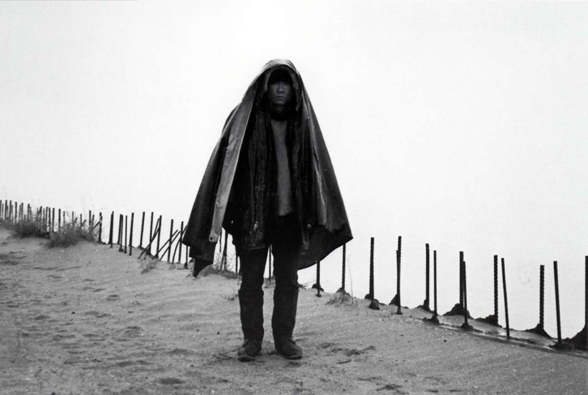Does duration matter? How long is a protest? How long is a movement? When is it “over”? In beginning this project, I had in mind durational performances, like those of Tehching Hsieh, while realizing that there is a very considerable difference between durational writing and embodied durational performance.
Tehching Hsieh (b. 1950) arrived undocumented in New York in 1974 from Taiwan via a job in merchant shipping. Four years later he began making astonishing year-long performances, beginning with Cage Piece (1978-79) in which he spent an entire year in a cage. He followed this with Time Clock Piece (1980-81) in which he endeavored to punch a time clock every hour over the course of a year, missing only 134 hours over the course of the year.
His next project, Outdoor Piece (1981-82), has a striking resonance today. “I shall stay OUTDOORS for one year, never go inside. / I shall not go in to a building, subway, train, car, airplane, ship, cave, tent. / I shall have a sleeping bag.” Hsieh occupied New York. He did not go near Wall Street, though.
In the film documentation embedded below you can get a feel for the project from Hsieh’s preparations, his sleeping, eating and grooming arrangements over the course of the piece and how he passed his time.
In the last few minutes of the film, the crisis of the project arises, when the NYPD arrest Hsieh for being involved in a fight. From what his lawyer says later it seems that Hsieh was attacked and defended himself, but the police take him inside a police station, causing him obvious distress. In one of many distinctions between present-day New York and the time of the project, Hsieh is permitted by the judge in his case not to come inside to his hearing because he is a “serious artist.”
You notice many other little details: the availability of pay phones, food vendors that sell out of the window to the sidewalk and street markets allows Hsieh to sustain his project and make use of a range of commodities, all of which would be much harder now. He makes a call next to a cop but is not harassed as present-day street people and Occupiers alike tend to be.
In the other hand, it’s often pointed out that it was the proximity of a McDonalds and a Starbucks to Zuccotti Park that allowed the occupiers access to bathrooms that enable the park to remain sanitary. Hsieh did not have that option, as the film shows. He has to make do as best he can, washing from fire hydrants and urinating in the open.
In other ways, Hsieh did not stand out as much as the occupiers did. As one can see in the film, there were numerous indeterminate “zones” in the city, such as the river bank on the West side and even Washington Square Park, where flexible living arrangements were tolerated. Indeed, the homeless population in both New York and the US in general began to expand dramatically in 1981, leading to the foundation of the Coalition for the Homeless in that year. It was not until 1983 that the New York Times began to refer to homeless people as opposed to vagrants.
What can we learn from Hsieh’s experience of duration? He has said that he did not find the performances difficult but that he was “depressed” afterwards. There is a relation of time, work and narrative here. Time is measured in his projects, whether by the punching of the clock or by the full duration of the project, but it is not a relation to alienated labor. It makes us realize how much our sense of time is dictated by work, from the so-called 9-5, to the weekend, the “holidays” and so on. We do not experience time as a measure of life or of understanding but more as a burden–as in the “thank god that’s over” response.
Hsieh’s work makes us understand that the Hollywood version of narrative is always already about moving through a predictable “arc” to the predetermined ending. Investment, going to market, followed by profit has been laid over the classical exordium, agon, catharsis. There is no catharsis in the market relation. It is a narrative without reward other than the shadow of supposedly increased value.
Instead, Hsieh stayed in the moment–for a year. From Buddhist philosophy to revolutionary praxis, the task is precisely to stay in the moment, not to move on but stay there where always were but differently: as ourselves, between ourselves, not in predetermined market relations. Don’t go back.

